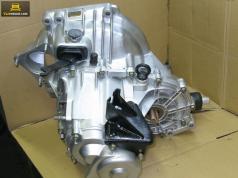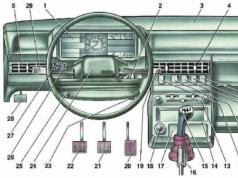As you know, replacing the timing belt VAZ 2110 should be carried out every 100 thousand km of mileage. But it often happens that the replacement of the timing belt VAZ 2110 8 valves or 16 is carried out in the case when this part is strongly wearing for a number of reasons.
In this article, consider how to carry out this operation yourself, without the use of any special equipment.
What is this detail
In principle, when removing any difficulties arise and should not. Just need to be remembered by conducting this operation with your own hands that it is impossible to carry or twist the belt in any way.
To begin with, you should prepare everything in such a way as to provide free access to the belt. It will help easily and quickly remove it.
We usually dismantle such components as:
- Pulleys of a wedge belt (you will need both);
- Be sure to dismantle the air filter;
- Remove servo power steering.
Still, before starting to describe all the subtleties of the replacement, it will be useful to know what the timing belt is. In essence, this is a special component of the gas distribution mechanism, which depends a lot.
The breakdown of him is so dangerous that he does not bring God. Therefore, timely replacement it is so important.
The timing belt is a rubber-metal type chain with teeth. Shells made on the belt are placed on the inside of this part.
Being a kind of synchronizer, the timing belt provides normal rotation of the crankshaft and the camshaft in the engine.

Do not talk about how important the synchronicity of the work of both shafts is. After all, thanks to the agreed work of two shafts, the main task of the gas distribution mechanism is ensured - to insert the fuel mixture and produce exhaust gases.
As you know, the inlet and release passes through intake and exhaust valves.
Note. In addition, the task of the timing belt is that the camshaft rotates at a speed, which in this case has a crankshaft.
Now about rollers.
Under the pulleys of the camshafts there are always placed two rollers:
- The roller is a support, having a special hole through which it is fixed (if you look pretty well, you can see that the hole is not right in the center, so that you can adjust the TRG strap stretch);
- Tension roller.
Gas distribution scheme

The timing consists of the following elements:
- pulley having toothed design;
- actually belt timing;
- pulley, ensuring the operation of the water pump;
- pulley, ensuring the operation of the camshaft of the exhaust valves;
- special stretch roller;
- rear protective lid belt;
- synchronizer phase sensor;
- bracket;
- springs;
- support roller.
In addition, the timing labels always have installation marks:
- on the lid;
- on the rear lid of the belt;
- on pulleys.
The pulleys themselves are not similar to each other. In particular, a synchronization disc or ring is recorded to the camshaft pulley, which ensures the normal operation of the phase sensor.
The drive itself is closed with a plastic cover on both sides. This is tested by the labels, then they are intended for the correct installation of the phases of gas distribution, and they must coincide in pairs.
Dangers of belt cliff
Now consider what can happen if this belt breaks. The safest moment may be when the timing belt breaks the contact of the valve with the piston.
In such a situation, it will definitely bendled a plate of a plate or the feet of the valve (intake or graduation). Of course, you can repair and in this case, but it will definitely do not in a penny.
Some manufacturers, protecting the engine from such a danger, put special circuits in pistons or simply speaking, notes, created in order to minimize breakdowns and the consequences of the timing belt cliff. Specialists know that on some vazov engines the valves are bent, and others do not be rushing.
Below is the VAZ motor, where the valves are bent after the timing belt break:
- DVS VAZ 2110 1.5 L with two rows of valves (16 valve).
But on these motors the valves are not bent:
- DVS VAZ 2110 1.5 l per 8 valves;
- DVS VAZ 2110 1.6 l per 8 valves;
- DVS 1.6 l 16 valve.
The valve is also flexing on motors from priors and viburnum.
Replacement process
When is the replacement of the belt? If you naively believe the manufacturer and hope that it will stretch all 100 thousand km of run, not to avoid problems.
An experienced and competent driver always conducts a visual inspection, noticing such replacement signals as:
- traces of belt oil;
- excessive wear of teeth located on the inside of the surface of the belt or crack;
- various strap belt, cuts, bundles, etc.;
- the appearance of hanging threads and springs of the belt.
Note. It will not be superfluous to check the roller tensioners, which if faulty, is able to cause tremendous damage not only the belt, but also the main parts of the engine.
Replacement is carried out using the following tools:
- keys at 15 and 17 (ordinary and precipitant);
- a special key that can be adjusted by a tension roller;
- special puller for locking rings;
- matching or long screwdriver.
Dismantling belt
We start the replacement presented here in the form of a step-by-step instruction:
- de-energize the battery;
- generator drive belt dismantle;
- we establish the piston of the first cylinder into the position of the upper ground point;

- we take the key to 15 and turn the bolt that fixes the tension roller;
- after that, the tensioner roller turn a little to the timing belt stretch decreased;

Note. To easily turn the bolt, fixing the generator drive, you need to go to the crankshaft mount so that it does not turn. It is better to use the services of an assistant who will hold the crankshaft from turning while the bolt turns away.
- next, we take a cape key on 17 and turn the bolt that locks the crankshaft pulley;
- remove it with the puck;
- dismantle the pulley of the generator drive;
- remove, but very carefully, the puck from the drive pulley;

- remove the timing belt from the crankshaft pulley.
Installation
Before starting the installation of a new timing belt, you should prepare everything carefully. First of all, it concerns cleaning from oil and dirt pulley, as well as cleaning the tensioning roller.
Note. If the parts are strongly contaminated, it is recommended to use a rag moistened in gasoline or white alcohol.
So:
- intim the pulley of the generator drive in place (there is a special secession that needs to be put in place);

- we put a new belt in place.
Note. When installing a new belt, you should pay attention to the tension of the leading branch.
- arming with a special key and puller;
- the key is inserted into the tension roller grooves located on the outside;
- turn the roller until the cutout on the disk and the protrusion on the inner sleeve of the stretch roller will not coincide (the protrusion is rectangular);
- we take the key to 15 and tighten the bolt, locking the tensioning roller.
Note. If, after installing the belt, the characteristic noise in the camshaft is heard, then it is likely that there are problems with the tension roller bearing, which is also of great importance for engine mechanisms.
To make sure that you should dismantle the rollers and start slowly rotate the bearing, making sure in the absence of a backlash or jealous. In addition, you need to pay attention to traces from oil leakage.
If the faults described above are detected, then the roller replacement is required.
Change this detail

To replace the tensioning roller, you will need to purchase a new one, which is not so expensive. It is also recommended to see this video.
Note. When installing a new tensioning roller, you need to ensure that the holes under the special key look out.
Tension checking
After replacement, and in general, in order to prevent prevention, it is customary to check the timing belt tension. Do it with the help of a special indicator, as shown in the photo below.

If there is no indicator, then you can apply the old "Dedovsky method".
To do this, armed with the following tools:
- caliper;
- the key to which the timing belt was pulled;
- mount (preferably fine, it is possible a long screwdriver);
- key;
- cleanman.
Begin:
- we take the shimman and clinging it for the handle of the key (you can, for example, to keep the hook of the shock to the ends with a tape).
Note. Making the hook with a hook to the overtook key, you need to ensure that the hook is on top of the key, and not below. Thus, the correct measurement will be ensured when pressing.
- we dismantle the top cover of the timing belt (if the check is carried out not after replacement);
- we raise the right part of the car by jack;
- removing the dirt shield of the engine compartment;
- now we take the key to 17 and begin to gently rotate the crankshaft for the pulley bolt (you need to carefully inspect the belt);
- check the belt tension in its middle part, laying the mount and pressing the end key with a power of 10 kg to the belt (using a caliper measure the deflection of the default mounted).
Note. If the tension is correct, then the belt deflection must be 5.4 mm in this place. If the deflection is greater or less, then you need to stretch accordingly or weaken it.
We remember that the strong tension of the timing belt is able to lead to a significant decrease in its period of operation, the rapid failure of the tension roller and even wear of the pump bearing.
Council. Adjustment is carried out using a key on 17, which weaken or stretch the nut fixing the tensioner roller.
That's all! With my own hands, it was possible not only to replace the timing belt, but also to carry out its correct tension.
The main thing in this business is to do everything as advises the instruction. Having learned this, you can safely save a family budget, because the price for services of this kind in car services is quite high.







